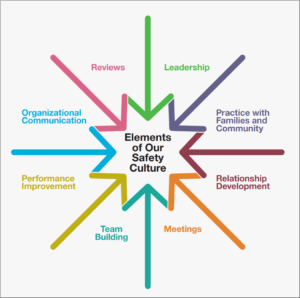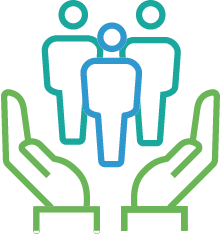The Office of Training and Workforce Development (OTWD) is undertaking organizational change in a number of ways, including psychological skills/emotional intelligence and strengths-finding exercises. But its most intensive efforts involve the adoption of two leading edge initiatives — Reflective Process (RP) and Safety Culture — and the customization of them to best suit the needs of its staff and the wider ACS community. These widely respected programs for staff well-being and effectiveness both ask, “What can we improve?” rather than, “Whom can we blame?” Both share the vision for all staff to feel respected and appreciated. Both empower teams to work better together against racism and oppression within systems. Both foster an atmosphere where everyone feels safe to discuss challenges and vulnerabilities within the system without fear of retaliation.
Reflective Process (RP) meetings are held bi-weekly, facilitated by an external consultant, the Village RDI™ (Race, Diversity & Intersectionality) Reflective Process.
Safety Culture orientation sessions are held on an ongoing basis. A new eLearning course, Embracing a Safety Science Culture, focuses on accountability and the underlying systemic factors that are often present when adverse events occur. Local action teams (LATs) throughout ACS are testing activities and practices to help implement Safety Culture.
Roots and Customizations for OTWD
Reflective Process (RP) is widely used in social service, health, education, and mental health settings. Studies have shown that it supports decision making that leads to positive outcomes for people served. For OTWD staff, RP sessions take place in emotionally supportive and accountable spaces. Staff are encouraged to discuss systemic racism and oppression — and the impact on self, colleagues, clients, and the community. OTWD has adopted RP and customized it as a unique model, to include issues of equity across race, diversity and intersectionality. Positive relationships among staff are at its core.
 Safety Culture has its roots in safety science, long used in healthcare, commercial aviation and nuclear power industries. All these industries operate with high risks to worker health and safety, along with high consequences to human life or quality of life when things go wrong. Child welfare is the same. Its workers face the risk of their own physical and emotional trauma, operating in an often-hostile environment of child abuse and maltreatment. Their case outcomes are also high consequence, profoundly affecting the lives and quality of life for themselves and their clients.
Safety Culture has its roots in safety science, long used in healthcare, commercial aviation and nuclear power industries. All these industries operate with high risks to worker health and safety, along with high consequences to human life or quality of life when things go wrong. Child welfare is the same. Its workers face the risk of their own physical and emotional trauma, operating in an often-hostile environment of child abuse and maltreatment. Their case outcomes are also high consequence, profoundly affecting the lives and quality of life for themselves and their clients.
OTWD has taken a proactive position in creating a Safety Culture. A recent editorial in The Imprint suggests that OTWD is on the right track:
“… the primary lesson to be learned is the value of incorporating and embracing safety science as a North Star for child welfare …. And with many child welfare systems working toward a more preventative, upstream approach, there has never been a more important time to weave this into the fabric of the field.” In 2018, then-Commissioner David Hansell (2017-2022) underscored the importance of improvement over blame: “We want to build an organizational culture that feels safe for all … an atmosphere where everyone feels safe to discuss challenges and vulnerabilities within the system.”
Safety Culture is a visible example of organizational change. ACS Associate Commissioner Cheryl Beamon acknowledges that organizational change is a process that requires humility and ongoing commitment to a variety of actions and conversations. “We recognize that a strong organization supports its staff to allow them to be more effective and stronger at their jobs,” says Beamon, “And that support in turn also helps to drive our agency with our families.”
The foundation of this work is the ACS Safety Culture Framework, which describes the eight core elements customized to drive Safety Culture in OTWD and throughout ACS. The Framework also highlights OTWD’s commitment to equity and anti-racism.
The Impact of RP and Safety Culture
For Sabrina Toledo, Community Coordinator, Policy, Planning and Measurement: “Reflective Process influences how I bring together my now and there … my evolvement tool. I use it to elicit introspective wonder and reflective learning. To balance the contextualization in diversity and to support one’s lived experiences.”
For Jing (Chelsea) Zhang, Deputy Director of Budget and Scope Management, RP sessions are a powerful means to connect with colleagues and continue to be “an eye-opening experience”. She appreciates the chance to absorb the perspectives of colleagues from diverse backgrounds. She is losing her reluctance to speak up in meetings, encouraged by respect and lack of judgment during RP sessions.
For Wendy Brown, Assistant Commissioner, Child Protection, LATs are an integral part of Safety Culture: “Having a Local Action Team in Brooklyn East has been such a life-changing experience. It has allowed us to slowly change the culture of the agency and challenges us to be mindful of how we are implementing and practicing Safety Culture throughout our everyday work, especially during supervision. Having all levels of staff on the LAT is incredibly helpful as you can see the behavioral and language shifts.”
Successful Rollouts in FY22
RP sessions have been rolled out and all Workforce Institute and James Satterwhite Academy (JSA) staff have been given the opportunity to enroll and participate in any of these 90-minute sessions that suit their schedule.







